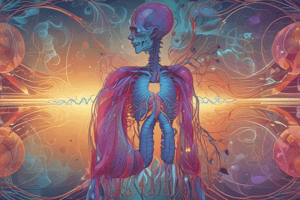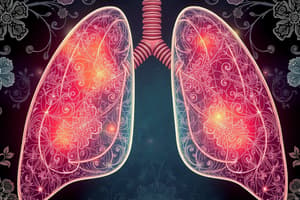Podcast
Questions and Answers
How does the body adjust during exercise to maintain adequate gas exchange, according to the principles governing lung diffusing capacity?
How does the body adjust during exercise to maintain adequate gas exchange, according to the principles governing lung diffusing capacity?
- By decreasing the perfusion of capillaries, reducing the surface area for gas exchange.
- By increasing the perfusion of capillaries, which increases the surface area for gas exchange. (correct)
- By increasing the thickness of the alveolar membrane to facilitate slower, more complete diffusion.
- By increasing the amount of hemoglobin in red blood cells to enhance oxygen binding.
In scenarios where the A-a difference is observed to be larger than usual, what condition is most likely indicated?
In scenarios where the A-a difference is observed to be larger than usual, what condition is most likely indicated?
- A reduced efficacy in oxygen transfer, potentially due to an increased physiological shunt. (correct)
- An increased efficacy in oxygen transfer within the lungs.
- A normal and healthy gas exchange process.
- A decreased physiological shunt, leading to more oxygen in the arterial blood.
If a patient's alveolar air has a P_O2 of 100 mm Hg and a P_CO2 of 40 mm Hg, what is the primary reason for these specific partial pressures compared to inspired air?
If a patient's alveolar air has a P_O2 of 100 mm Hg and a P_CO2 of 40 mm Hg, what is the primary reason for these specific partial pressures compared to inspired air?
- The partial pressures remain constant due to the static environment within the lungs.
- Oxygen is transferred from the blood into the alveoli, increasing P_O2, while carbon dioxide is expelled from the alveoli into the blood, decreasing P_CO2.
- Oxygen is transferred to the blood and carbon dioxide is expelled into the alveoli. (correct)
- The inspired air is directly drawn into the alveoli without any alteration.
How is the partial pressure of a gas in humidified air calculated, taking into account water vapor at body temperature?
How is the partial pressure of a gas in humidified air calculated, taking into account water vapor at body temperature?
Which of the following best describes the physiological significance of nitrogen (N2) in respiratory measurements?
Which of the following best describes the physiological significance of nitrogen (N2) in respiratory measurements?
A patient's blood gas analysis reveals a low concentration of dissolved oxygen despite a normal partial pressure of oxygen in the alveoli. Which factor is most likely contributing to this?
A patient's blood gas analysis reveals a low concentration of dissolved oxygen despite a normal partial pressure of oxygen in the alveoli. Which factor is most likely contributing to this?
According to Boyle's Law, what happens to the pressure within the lungs during inspiration, assuming a constant temperature?
According to Boyle's Law, what happens to the pressure within the lungs during inspiration, assuming a constant temperature?
What is the primary reason for using BTPS conditions when applying the general gas law to respiratory physiology?
What is the primary reason for using BTPS conditions when applying the general gas law to respiratory physiology?
In accordance with Dalton's Law, if the barometric pressure is 760 mm Hg, and the fractional concentration of oxygen in dry air is 21%, what is the partial pressure of oxygen (P_O2)?
In accordance with Dalton's Law, if the barometric pressure is 760 mm Hg, and the fractional concentration of oxygen in dry air is 21%, what is the partial pressure of oxygen (P_O2)?
Carbon dioxide is transported in the blood in several forms. Which form accounts for the majority of CO2 transport?
Carbon dioxide is transported in the blood in several forms. Which form accounts for the majority of CO2 transport?
Flashcards
Gas Exchange
Gas Exchange
Diffusion of O2 and CO2 in lungs and peripheral tissues.
General Gas Law
General Gas Law
Product of pressure and volume equals moles times gas constant times temperature (PV=nRT).
Boyle's Law
Boyle's Law
At constant temperature, pressure and volume are inversely proportional (P1V1=P2V2).
Dalton's Law
Dalton's Law
Signup and view all the flashcards
Fick's Law
Fick's Law
Signup and view all the flashcards
Lung Diffusing Capacity (Dl)
Lung Diffusing Capacity (Dl)
Signup and view all the flashcards
Henry's Law
Henry's Law
Signup and view all the flashcards
Chemically Modified Gas
Chemically Modified Gas
Signup and view all the flashcards
Physiologic Shunt
Physiologic Shunt
Signup and view all the flashcards
Study Notes
- Gas exchange in the respiratory system involves the diffusion of O2 and CO2 in the lungs and peripheral tissues
- O2 moves from alveolar gas to pulmonary capillary blood and then to tissues
- CO2 moves from tissues to venous blood, then to pulmonary capillary blood, and finally to alveolar gas for expiration
Gas Laws
- Gas exchange relies on the fundamental properties of gases, including their behavior in solution
- The general gas law states that the product of pressure and volume equals the number of moles times the gas constant times temperature, PV = nRT
- P = Pressure in mm Hg, V = Volume in Liters, n = Moles, R = Gas constant, T = Temperature in Kelvin
- Respiratory physiology uses BTPS (body temperature, ambient pressure, saturated with water vapor) for the gas phase and STPD (standard temperature, pressure, dry) for the liquid phase
- STPD includes standard temperature (0°C or 273 K), standard pressure (760 mm Hg), and dry gas
- Converting gas volume from BTPS to STPD involves multiplying the volume at BTPS by 273/310 x (Pb - 47)/760, where Pb is barometric pressure and 47 mm Hg is water vapor pressure at 37°C
- Boyle's Law states that at a given temperature, the product of pressure and volume for a gas remains constant, P1V1 = P2V2
- Inspiration involves diaphragm contraction, increasing lung volume and decreasing gas pressure
Dalton's Law
- Dalton's Law of Partial Pressures states that the partial pressure of a gas in a mixture is the pressure that gas would exert if it occupied the total volume
- Partial pressure equals total pressure multiplied by the fractional concentration of dry gas, Px = PB x F
- PX = Partial pressure of gas in mm Hg, PB = Barometric pressure in mm Hg, PH2O = Water vapor pressure at 37°C which is 47mm Hg, F = Fractional concentration of gas
- Barometric pressure (PB) sums the partial pressures of O2, CO2, N2, and H2O
- Gases in dry air at 760 mm Hg: O2 is 21% (0.21), N2 is 79% (0.79), CO2 is 0% (0.0004)
- Airway humidification results in water vapor pressure of 47 mm Hg at 37°C
- CX = PX x Solubility, where CX is the dissolved gas concentration, PX is the partial gas pressure, and Solubility is the gas's solubility in blood
Diffusion of Gases (Fick's Law)
- Gas transfer across cell membranes or capillary walls occurs via simple diffusion
- The rate of transfer by diffusion (Vx) is directly proportional to the driving force, diffusion coefficient, and surface area, and inversely proportional to membrane thickness
- Vx = (D x A x ΔP) / Δx, where Vx is the volume of gas transferred per unit time, D is the diffusion coefficient, A is the surface area, ΔP is the partial pressure difference, and Δx is the membrane thickness
Lung Diffusing Capacity
- Lung diffusing capacity (Dl) combines the diffusion coefficient, surface area, and membrane thickness
- Dl accounts for the time it takes for gas to combine with proteins in pulmonary capillary blood, like O2 binding to hemoglobin
- Dl is measured using carbon monoxide (CO), due to the CO transfer across the alveolar/pulmonary capillary barrier is diffusion-limited
- Dl decreases in emphysema due to decreased surface area, in fibrosis or pulmonary edema due to increased diffusion distance, and in anemia due to reduced hemoglobin
- Dl increases during exercise due to additional capillaries being perfused with blood
Gas Transport Forms
- In alveolar air, gas exists as partial pressure however in blood, gases are dissolved, bound to proteins, or chemically modified
- Total gas concentration in solution is the sum of dissolved, bound, and chemically modified gas
- Henry's Law states that at a given partial pressure, higher solubility means higher concentration
- Only dissolved gas molecules contribute to partial pressure
- Nitrogen (N2) is only carried in dissolved form, and because it is never bound or chemically modified, it is used for respiratory physiology measurements
- O2 and CO bind to hemoglobin inside red blood cells (O2 and CO) and in plasma proteins (CO2)
- Most CO2 is carried as bicarbonate (HCO3-) in red blood cells via carbonic anhydrase
Gas Transport in the Lungs
- Pulmonary capillaries are perfused with mixed venous blood from the right heart
- Gas exchange occurs: O2 diffuses from alveolar gas into pulmonary capillary blood, and CO2 diffuses from pulmonary capillary blood into alveolar gas
- Blood leaving the pulmonary capillary enters the left heart and becomes systemic arterial blood
- In dry inspired air, oxygen partial pressure (P_O2) is about 160 mm Hg (21% of 760 mm Hg)
- Airway humidification dilutes oxygen, resulting in P_O2 of about 150 mm Hg (after subtracting water vapor pressure)
- Alveolar air has lower P_O2 (100 mm Hg) and higher P_CO2 (40 mm Hg), due to gas exchange
- Blood entering pulmonary capillaries is mixed venous blood with lower oxygen and higher carbon dioxide (P_O2 ≈ 40 mm Hg, P_CO2 ≈ 46 mm Hg)
- Oxygenated blood leaving pulmonary capillaries is arterial blood with higher oxygen (P_O2 ≈ 100 mm Hg)
- A physiologic shunt creates a slight difference between oxygen levels in alveolar air and systemic arterial blood, which can include any bronchial and coronary venous blood.
Difference in Lung Diseases
- In lung diseases, the shunt increases, causing disparity in gas exchange
- The A-a gradient, the difference in oxygen between alveolar air and arterial blood, indicates inefficiency in oxygen transfer in the lungs
Studying That Suits You
Use AI to generate personalized quizzes and flashcards to suit your learning preferences.
Related Documents
Description
Explore gas exchange in the respiratory system, focusing on O2 and CO2 diffusion in the lungs and tissues. Understand the general gas law (PV=nRT) and its application in respiratory physiology. Learn about BTPS and STPD conditions and their significance in gas volume conversion.




